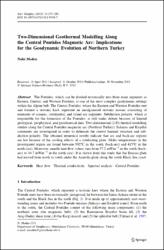Two-dimensional geothermal modeling along the Central Pontides magmatic arc (Northern Turkey)

Göster/
Erişim
info:eu-repo/semantics/restrictedAccessTarih
2012-01-01Erişim
info:eu-repo/semantics/restrictedAccessÜst veri
Tüm öğe kaydını gösterÖzet
The Pontides, which can be divided tectonically into three main segments as Eastern, Central, and Western Pontides, is one of the most complex geodynamic settings within the Alpine belt. The Central Pontides, where the Eastern and Western Pontides met and formed a tectonic knot, represent an amalgamated tectonic mosaic consisting of remnants of oceanic, continental, and island arc segments. Subduction polarity, which is responsible for the formation of the Pontides, is still under debate because of limited geological, geophysical, and geochemical data. Two-dimensional (2-D) thermal modelling studies along the Central Pontides magmatic arc (Northern Turkey), Sakarya and Kırs¸ehir continents are investigated in order to delineate the crustal thermal structure and subduction polarity. The obtained numerical results indicate that arc and back-arc regions are hot because of the cooling effects of a subducting plate. Moho temperatures in the investigated region are found between 992 C in the south (back-arc) and 415 C in the north (arc). Moreover, mantle heat flow values vary from 57.2 mWm-2 in the south (backarc) to 34.7 mWm-2 in the north (arc). It is shown from this study that the Eurasia plate had moved from north to south under the Anatolia plate along the south Black Sea coast.
Bağlantı
https://hdl.handle.net/20.500.12440/180https://link.springer.com/article/10.1007/s10712-011-9158-7?utm_source=getftr&utm_medium=getftr&utm_campaign=getftr_pilot

















